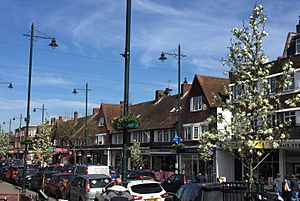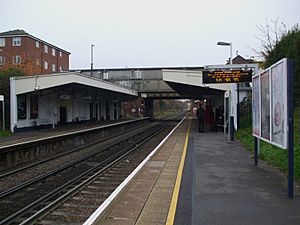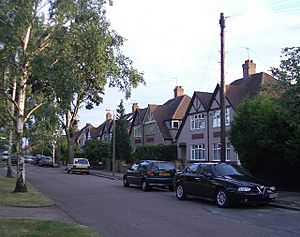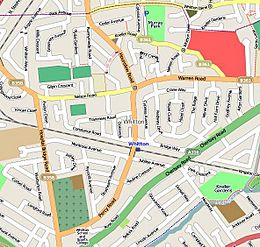Whitton, London facts for kids
Quick facts for kids Whitton |
|
|---|---|
 The High Street |
|
| Area | 3.56 km2 (1.37 sq mi) |
| Population | 20,065 (2011 Census Heathfield+Whitton 2011) |
| • Density | 5,636/km2 (14,600/sq mi) |
| OS grid reference | TQ145735 |
| London borough | |
| Ceremonial county | Greater London |
| Region | |
| Country | England |
| Sovereign state | United Kingdom |
| Post town | TWICKENHAM |
| Postcode district | TW2 |
| Post town | HOUNSLOW |
| Postcode district | TW3, TW4 |
| Post town | ISLEWORTH |
| Postcode district | TW7 |
| Dialling code | 020 |
| Police | Metropolitan |
| Fire | London |
| Ambulance | London |
| EU Parliament | London |
| UK Parliament |
|
| London Assembly |
|
Whitton is a lively area in the London Borough of Richmond upon Thames, England. It used to be the north-western part of Twickenham and is bordered by the River Crane and the Duke of Northumberland's River.
Whitton High Street is famous for keeping its 1930s look. Most homes here are detached or semi-detached houses built in the 1930s. Whitton is located on the A316 road, which connects to the M3 motorway. Whitton railway station offers train services from London Waterloo to Windsor. Since it's mainly a place where people live, many residents travel to Central London for work.
Contents
- A Look Back: Whitton's History
- Ancient Times: Bronze Age Discoveries
- Norman Times: Whitton's Beginnings
- Tudor Era: Gunpowder and Grand Houses
- Stuart Period: Kneller Hall and the White Hart Inn
- Georgian Times: Whitton Park and Kew Gardens
- Victorian Era: Market Gardens and Railways
- Early 20th Century: Growth and New Roads
- World War II: Bombs and Brave Pilots
- Whitton's Economy
- Famous People from Whitton
- Fun Things to Do in Whitton
- Learning in Whitton: Schools
- Churches in Whitton
- Getting Around: Transport in Whitton
- Whitton's Location and Landscape
- Nearby Places
- Images for kids
A Look Back: Whitton's History
Whitton was part of Twickenham until 1862, when it became its own parish. This happened when the church of St Philip and St James opened. Later, in 1958, the parish was divided again because the area grew so quickly.
Ancient Times: Bronze Age Discoveries
In 1999, during digs near Whitton's western edge, archaeologists found parts of an Iron Age furnace. They also found holes where posts for a round house once stood. Along the River Crane, you can still find signs of old mills and other industrial sites. This part of the river is considered an important archaeological area.
Norman Times: Whitton's Beginnings
During the Norman period, Whitton was a rural area in the west of Twickenham. Twickenham was part of the Manor of Isleworth, which was in the ancient county of Middlesex. Before the Normans, the manor belonged to Ælfgar, Earl of Mercia. After 1066, William the Conqueror gave it to Walter de Saint-Valery.
Tudor Era: Gunpowder and Grand Houses
Around 1540, people started making gunpowder on Hounslow Heath, which covered a large part of Twickenham. The gunpowder mills were built by the River Crane, away from towns, to reduce danger from explosions. These mills were used until 1927.
By the 1500s, fancy houses began to appear in the Whitton area as fashionable people from Twickenham spread out. Sir John Suckling, a courtier, built a house near what is now Murray Park. His son, the poet Sir John Suckling, was born in Whitton in 1609.
Stuart Period: Kneller Hall and the White Hart Inn
Around 1640, Edmund Cooke built a large house in the village centre. In 1709, the famous painter Sir Godfrey Kneller bought it. He tore it down and built a bigger house, said to be designed by Sir Christopher Wren. This house was first called Whitton Hall, but after Kneller died in 1723, it became Kneller Hall. It was changed a lot by later owners. In 1847, the government bought it for a teacher training college. It later became home to the Royal Military School of Music.
The White Hart, an old inn, stands in the middle of the original village, close to Kneller Hall. It dates back to at least the mid-1600s. Records from 1685 show it had three beds and stables for ten horses. This suggests Whitton was more important for travellers than its small size might suggest.
Georgian Times: Whitton Park and Kew Gardens
At the northern end of Whitton was Whitton Park, a large estate owned by Archibald Campbell, 3rd Duke of Argyll. The Duke started his estate in 1722. He loved gardening and brought in many rare plants and trees. He got advice from the Scottish gardener James Lee. After the Duke died in 1761, his nephew, John Stuart, 3rd Earl of Bute, moved many of these plants and trees to the Princess of Wales' new garden at Kew. This garden later became Kew Gardens. Some of the Duke's original trees can still be seen at Kew Gardens today.
Victorian Era: Market Gardens and Railways
Whitton was well-known for its market gardens, growing beautiful roses, narcissi, lilies of the valley, and many apple, plum, and pear trees. Until the 1920s, open fields still separated the village from nearby towns. Much of the old village's charm remained until the 1940s.
When railways arrived in the mid-1800s, some houses were built along Nelson, Kneller, and Hounslow Roads. Whitton was first served by what is now Hounslow railway station, which opened in 1850.
Early 20th Century: Growth and New Roads
Whitton grew very quickly after Whitton railway station opened in 1930. Houses replaced the market gardens and the old Whitton Park estate. New shops were built along Percy Road, from the station to Nelson and Hounslow Roads. This part of Percy Road was then renamed High Street Whitton.
Around the same time, the A316 Chertsey Road was built through the south of the area. Today, this road leads to the M3 motorway, connecting to places like Southampton and the South West of England.
World War II: Bombs and Brave Pilots
During the early years of World War II, some houses in Whitton were damaged by enemy bombs. In June 1944, a V-1 flying bomb directly hit 81 High Street. Part of the shops and flats above were completely destroyed, and several people lost their lives. Around the same time, another V-1 destroyed a house on Lincoln Avenue, damaging nearby homes too.
During the Blitz, it was common to see RAF fighter planes taking off from nearby airfields. They flew so low you could often see the pilots in their cockpits.
Whitton's Economy
Most people who live in Whitton travel outside the town for work. Many commute to Central London using the good transport links. Others work in nearby areas like Twickenham and Richmond, or larger centres like Hounslow and Kingston upon Thames. London Heathrow Airport is also important for local jobs and for international companies in the Thames Valley area.
Whitton's town centre is the third largest in Richmond upon Thames. In 2014, it received £2 million for improvements, including new streetlights and pavements. The railway station also had a £5 million upgrade, finished in December 2016.
Famous People from Whitton
- Phil Collins (born 1951), a famous musician.
- Elvis Costello (born 1954), another well-known musician.
- Sir Godfrey Kneller (1646–1723), a portrait painter who built a house in Whitton.
- Munira Wilson (born 1978), a Member of Parliament.
- Lucy Irvine (born 1956), a British adventurer and author.
Fun Things to Do in Whitton
A third of the borough is green space, which is five times more than any other London borough. This means Whitton has many options for fun activities!
Parks and Open Spaces
Whitton has a long park along the River Crane, London and five smaller local parks. These parks have sports facilities and playgrounds for children. There are also three cemeteries. Close by are the large Bushy Park and Richmond Park, which are managed by The Royal Parks. Hounslow Heath, a big open space and nature area, is also popular with residents.
- Borough Cemetery is located along Powder Mill Lane.
- Heathfield Recreation Ground ("the Rec") opened in the 1930s and has sports fields. In 2022, a new nature area called Jubilee Meadows was added.
- Hounslow Heath is just north of Whitton. It's one of the biggest open spaces in West London and is a nature reserve.
- Hounslow Heath Open Space is the part of Hounslow Heath within Richmond upon Thames. It's a recreation ground with a children's playground.
- Chase Green is a registered Village Green with a playground and a dog park.
- Crane Park, the largest nearby park, is to the south. It has different wildlife areas and is home to protected animals like bats and common kingfishers. The river here is also the historic border between Whitton and Twickenham.
- Hounslow Cemetery is along Hanworth Road.
- Kneller Gardens opened in 1931 and has open grass areas and playgrounds.
- Murray Park opened in 1914 and also has grass areas and playgrounds.
- Twickenham Cemetery opened in 1868 and is the main burial ground for Twickenham.
Cycling
Richmond is part of the London Cycle Network. This means there are cycle paths both on and off roads throughout the area.
Leisure Centres
The Whitton Sports and Fitness Centre, located at Twickenham School, has a modern gym, a sports hall, and astroturf pitches. There are also three large private health clubs near the town's border.
Sport Clubs
Whitton has several sports clubs, including the Whitton Lions rugby club and Hounslow and Whitton Cricket Club. Both are at the Whitton Park Sports Association. The Whitton Tennis Club is next to Kneller Hall.
Cinema
The Odeon cinema on the high street closed in 1961. Since then, residents have to travel to nearby towns to watch movies. The local council built a new arts centre in Twickenham with a 300-seat hall for theatre and cinema. It was planned to open in 2017.
Youth Centre
In September 2013, Richmond Council opened a youth centre behind Whitton High Street in Britannia Lane.
Heritage
In the 1700s, the Royal Court often stayed in Richmond and Hampton Court. This made Twickenham a very fashionable place to live, giving the area a special cultural history. Many residents remember visiting important historical houses near Whitton, such as Ham House, Hampton Court Palace, Marble Hill House, Sion House, and Strawberry Hill House. The only old country house left in Whitton is Kneller Hall, which was home to the Royal Military School of Music.
There is one Conservation Area nearby called Rosecroft Gardens. Also, there are several listed buildings like Kneller Hall and the Shot Tower at Crane Park.
Learning in Whitton: Schools
Primary Schools
Whitton has five primary schools. Two are voluntary-aided faith schools: Bishop Perrin Church of England Primary (opened 1936) and St. Edmund's Roman Catholic Primary (opened 1938). The other three are Chase Bridge Primary School, Heathfield Schools Partnership, and Nelson School.
Chase Bridge Primary and Heathfield Schools Partnership are run by the local council. Heathfield includes a nursery, infant, and junior school on one site. Nelson Primary (opened 1911) is now an academy.
Secondary Schools
Whitton has two secondary schools: Twickenham School on Percy Road and Turing House School on Hospital Bridge Road. An independent school, Radnor House, plans to move its older students to Whitton's Kneller Hall, if approved.
Many local children also attend other secondary schools in Richmond Borough or nearby areas. Some go to The Heathland's School in Hounslow or the Richmond upon Thames School (RTS) in Twickenham.
Churches in Whitton
In 1862, Whitton became its own parish, separate from St Mary's, Twickenham. The Church of St Philip and St James (Church of England) was built for this change. Later, in 1935, St Augustine of Canterbury, Whitton, was created due to population growth. In 1958, it became the parish of 'St. Augustine Whitton' when its new church opened.
Whitton Methodist Church, on Percy Road, now shares its building with Calvary Chapel Twickenham, which is a Baptist church.
A non-conformist Gospel Hall was built in 1881. This was later replaced by Whitton Baptist Church in Hounslow Road, which opened in 1935. Another Baptist church, The Free Grace Baptist Church, started in 1964 and meets in an old Salvation Army Hall.
The Catholic Church of St Edmund of Canterbury is on Nelson Road. It was opened in 1934.
Getting Around: Transport in Whitton
Roads
Whitton has good road connections and is less than 10 miles from the M25. It takes about 20 minutes to get to Kingston upon Thames, 5 minutes to Hounslow (or 10 minutes walking), and 10 minutes to Richmond.
The A316 road turns into the M3 at Sunbury-on-Thames and connects to the M25. Going the other way, the A316 passes through Twickenham town centre, then Richmond, Kew, Mortlake, and finally Chiswick, where it joins The Great West Road A4.
Trains
The main train service from Whitton railway station is the Windsor Line to London Waterloo. The 'semi-fast' service takes 30 minutes, while the 'stopping' service takes 40 minutes via Richmond or 50 minutes via Brentford. People living in the north of Whitton might use Hounslow instead, which is on the Hounslow Loop Line.
Since the London Underground doesn't serve the Twickenham area, people often change at Richmond for the District line, or at Hounslow East for the Piccadilly line.
Buses
Whitton is served by several London Buses routes: 110, 111, 281, 481, H20, and H22.
Whitton's Location and Landscape
Whitton is located between the two main centres of Hounslow to the north and Twickenham to the east. Most of the area is suburban housing. The land is mostly flat and fertile, about 60 to 70 feet above sea level. It used to have many market gardens until the early 1900s. The soil is mainly gravel with some clay.
The borough's main road, the A316, was built in the 1930s. Over time, some areas south of the A316 were moved to Twickenham. However, the Rosecroft Estate stayed with Whitton, helping to create a separate community identity.
Whitton residents have different postcodes. Some have Twickenham (TW2), Whitton, Hounslow (TW3 & TW4), or Isleworth (TW7). In 2015, Whitton became its own unique postal district. This means residents living on the border of Whitton and Hounslow can now use "Whitton" in their address.
Nearby Places
Whitton is surrounded by other residential areas. Other parts of Twickenham and its centre are close by. Larger nearby towns like Richmond, Hounslow, and Kingston upon Thames are also near. Richmond, especially, attracts people for its shopping and job opportunities.
 |
Hounslow West | Hounslow | Isleworth |  |
| Hanworth | Twickenham Centre |
|||
| Hampton | Fulwell | Teddington |
Images for kids







